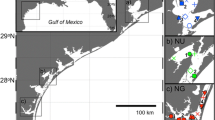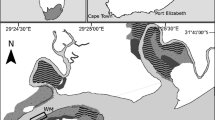Abstract
The muskellunge was introduced in the Saint John River system from stockings in a headwater lake in the 1970s. They have migrated down the system as far as the river’s first dam, Mactaquac Hydroelectric Facility, at Fredericton and appear to have established several reproducing populations along the river. This exotic invader represents a potential threat to the severely depleted Atlantic salmon stocks in the river. We radio-tracked muskellunge over a 2-year period in the middle reaches. Home ranges extended to ∼100 km in both riverine and lacustrine areas, including 78% of individuals trans-located upstream of the dam making their way back through the dam successfully. Downstream of the dam, home ranges were <25 km. No spawning areas were detected. An isotope analyses of diet indicated that the large sub-adults and adults had established the greatest proportion of their biomass in a more 15N depleted environment typical of areas farther upstream. Isotope mixing models could not accurately determine the proportion of Atlantic salmon smolts that may have been consumed by muskellunge, but anadromous salmon had ≤7% probabilities of being in the diet. A bioenergetics model suggested ≤5% of the annual food intake by muskellunge occurs during the smolt out-migration period. For the Saint John River, the impacts of growing numbers of muskellunge are multi-faceted creating a complex management challenge. Muskellunge appear to minimally increase predation risk for Atlantic salmon smolts while their increasing numbers are creating a growing recreational fishery and potential threat to the native fish community and ecosystem.





Similar content being viewed by others
References
Anderson C, Cabana G (2005) δ 15N in riverine food webs: effects of N inputs from agricultural watersheds. Can J Fish Aquat Sci 62:333–340
Bakshtanskiy EL, Nesterov VD, Neklyudov MN (1980) The behavior of young Atlantic salmon, Salmo salar, during downstream migration. J Ichthyol 20:93–100
Bevelhimer MS, Stein RA, Carline RF (1985) Assessing significance of physiological differences among three Esocids with a bioenergetics model. Can J Fish Aquat Sci 42:57–69
Blackwell BF, Juanes F (1998) Predation on Atlantic salmon smolts by striped bass after dam passage. N Am J Fish Manage 18:936–939
Connolly RM, Hindell JS, Gorman D (2005) Seagrass and epiphytic algae support nutrition of a fisheries species, Sillago schomburgkii, in adjacent intertidal habitats. Mar Ecol Prog Ser 286:69–79
Curry RA, Munkittrick KR (2005) Fish community responses to multiple stressors along the Saint John River, New Brunswick, Canada. In: JN Rinne, R Calamusso, R Hughes (eds) Historical changes in large river fish assemblages of the Americas, vol 45. American Fisheries Society Symposium, pp 505–521
Curry RA, van de Sande J, Whoriskey FG (2006) Temporal and spatial habitats of anadromousbrook charra in the Laval River and its estuary. Env Biol Fish 76:301–370
Curry RA, Sparks D, VandeSande J (2002) Movement patterns of a riverine population of brook trout. Trans Am Fish Soc 131:551–560
Dombeck MP (1986) Muskellunge habitat with guidelines for habitat management. Am Fish Soc Spec Publ 15:208–215
Doucett RR, Power G, Barton DR, Drimmie RJ, Cunjak RA (1996) Stable isotope analysis of nutrient pathways leading to Atlantic salmon. Can J Fish Aquat Sci 53: 2058–2066
Faangstam H (1993) Individual downstream swimming speed during the natural smolting period among young of Baltic salmon (Salmo salar) Can J Zool 71:1782–1786
France R (1995a) Critical examination of stable isotope analysis as a means for tracing carbon pathways in stream ecosystems. Can J Fish Aquat Sci 52:651–656
France R (1995b) Stable nitrogen isotopes in fish: literature synthesis on the influence of ecotonal coupling. Estuar Coast Shelf Sci 41:737–742
He X, Kitchell JF (1990) Direct and indirect effects of predation on a fish community: a whole-lake experiment. Trans Am Fish Soc 119:825–835
Hesslein RH, Hallard KH, Ramlal P (1993) Replacement of sulfur, carbon, and nitrogen in tissue of growing broad whitefish (Coregonus nasus) in response to a change in diet traced by δ 34S, δ 13C, and δ 15N Can J Fish. Aquat Sci 50:2071–2076
Huntingford FA, Metcalfe NB, Thorpe JE (1988) Choice of feeding station in Atlantic salmon, Salmo salar, parr: Effects of predation risk, season and life history strategy. J Fish Biol 33:917–924
Jardine TD, Gray MA, McWilliam SM, Cunjak RA (2005) Stable isotope variability in tissues of temperate stream fishes. Trans Am Fish Soc 134:1103–1110
Jepsen N, Aarestrup K, Okland F, Rasmussen G (1998) Survival of radio-tagged Atlantic salmon (Salmo salar L.) and trout (Salmo trutta L.) smolts passing a reservoir during seaward migration. Hydrobiologia 371/372:347–353
Jones, RA, Anderson L, Goff T (2004) Assessment of Atlantic salmon stocks in southwest New Brunswick: an update to 2003. Canadian Science Advisory Secretariat Research Document 2004/019, pp 70
Kelly MH, Hagar WG, Jardine TJ, Cunjak RA (2006) Non-lethal sampling of sunfish and slimy sculpin for stable isotope analysis: how scale and fin tissue compare with muscle tissue. N Am J Fish Manage 26:921–925
Krueger CC, Jones ML, Taylor WW (1995) Restoration of lake trout in the Great Lakes: challenges and strategies for future management. J Great Lakes Res 21:1
LaPan SR, Schiavone A, Werner RG (1996) Spawning and post-spawning movements of St. Lawrence River muskellunge, pp 73–82. In: Kerr SJ, Olver CH (eds) Managing Muskies in the ‘90s. Workshop Proceedings. Ontario Ministry of Natural Resources, Southern Region Science and Technology Transfer Unit Workshop Proceedings. WP-007, 169pp
Livingstone DA (1951) The freshwater fishes of Nova Scotia. N S Inst Sci 23:1–89
Madenjian CP, Fahnenstiel GL, Johengen TH, Nalepa TF, Vanderploeg HA, Fleischer GW, Schneeberger PJ, Banjamin DM, Smith EB, Bence JR, Rutherford ES, Lavis DS, Robertson DM, Jude DJ, Ebener EP (2002) Dynamics of the Lake Michigan food web, 1970–2000. Can J Fish Aquat Sci 59:736–753
McCutchan JH Jr, Lewis WM Jr, Kendall C, McGrath CC (2003) Variation in trophic shift for stable isotope ratios of carbon, nitrogen, and sulfur. Oikos 102:378–390
McKinley RS, Power G (1992) Transmitter attachment/implant—laboratory manual. University of Waterloo, Environmental Research Department, Waterloo, ON
Miller ML, Menzel BW (1986) Movement, activity, and habitat use patterns of muskellunge in West Okoboji Lake, Iowa. Am Fish Soc Spec Publ 15:51–61
Mohler JW, Millard MJ, Fletcher JW (2002) Predation by captive wild brook trout on calcein-marked versus nonmarked Atlantic salmon fry. N Am J Fish Manage 22:223–228
Neal JW, Noble RL, Rice JA (1999) Fish community response to hybrid striped bass introduction in small warmwater impoundments. N Am J Fish Manage 19:1044–1053
Naughton GP, Bennett DH, Newman KB (2004) Predation on juvenile salmonids by smallmouth bass in the lower Granite Reservoir system, Snake River N Am. J Fish Manage 24:534–544
Phillips DL, Gregg JW (2003) Source partitioning using stable isotopes: coping with too many sources. Oecologia 136:261–269
Phillips DL, Newsome SD, Gregg JW (2005) Combining sources in stable isotope mixing models: alternative methods. Oecologia 144: 520–527
Post DM (2002) Using stable isotopes to estimate trophic position: models, methods, and assumptions. Ecology 83:703–718
Scott WB, Crossman EJ (1973) Freshwater fishes of Canada. Bulletin 184. Fisheries Research Board of Canada, Ottawa
Simonson TD, Hewett SW (1999) Trends in Wisconsin’s muskellunge fishery. N Am J Fish Manage 19:291–299
Stocek RF, Cronin PJ, Seymour PD (1999) The muskellunge, Esox masquinongy, distribution and biology of a recent addition to the ichthyofauna of New Brunswick. Can Field Nat 113:230–234
Strand RF (1986) Identification of principle spawning areas and seasonal distribution and movement of muskellunge in Leech Lake Minnesota. Am Fish Soc Spec Publ 15:62–73
Tanner HA, Tody WH (2002) History of the Great Lakes salmon fishery: a Michigan perspective. In: Lynch KD, Jones ML, Taylor WW (Eds) Sustaining North American salmon: perspectives across regions and disciplines. American Fisheries Society, Bethesda, pp 139–154
Townsend CR (2003) Individual, population, community, and ecosystem consequences of a fish invader in New Zealand streams. Conserv Biol 17:38–47
Vanderklift MA, Ponsard S (2003) Sources of variation in consumer-diet δ 15N enrichment: a meta analysis. Oecologia 136:169–182
VanderZanden MJ, Casselman JM, Rasmussen JB (1999) Stable isotope evidence for the food web consequences of species invasions in lakes. Nature 401:464–467
Warner K, AuClair RP, DeRoche SE, Havey KA, Ritzi CF (1968) Fish predation on newly stocked landlocked salmon. J Wildl Manage 32:712–717
Wynne F (1995) Outlook for the culture of muskellunge, northern pike and chain pickerel in Kentucky, USA. World Aquac 26:41–44
Acknowledgements
We thank M. Gautreau, A. Halford, K. Roach, and C. Cronin for muskellunge collections and tracking and T. Goff and S. Ratelle, Fisheries and Oceans, Canada—Mactaquac Biodiversity Centre, for muskellunge and fish collections at the Mactaquac Dam. Reviews by R. Jones, J. Bagnall, C. Ayer, and two anonymous reviewers were most useful.
Author information
Authors and Affiliations
Corresponding author
Rights and permissions
About this article
Cite this article
Curry, R.A., Doherty, C.A., Jardine, T.D. et al. Using movements and diet analyses to assess effects of introduced muskellunge (Esox masquinongy) on Atlantic salmon (Salmo salar) in the Saint John River, New Brunswick. Environ Biol Fish 79, 49–60 (2007). https://doi.org/10.1007/s10641-007-9187-8
Received:
Accepted:
Published:
Issue Date:
DOI: https://doi.org/10.1007/s10641-007-9187-8




